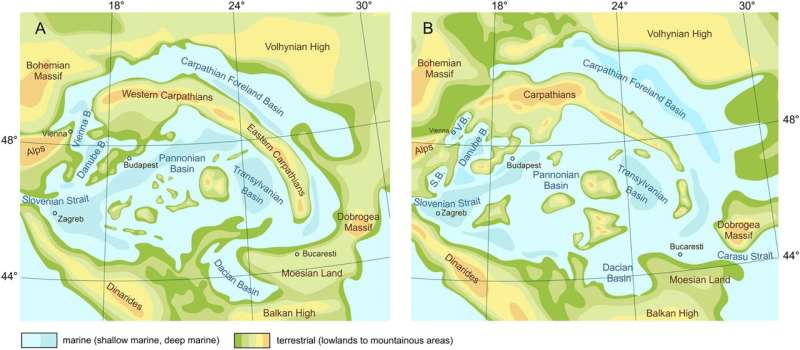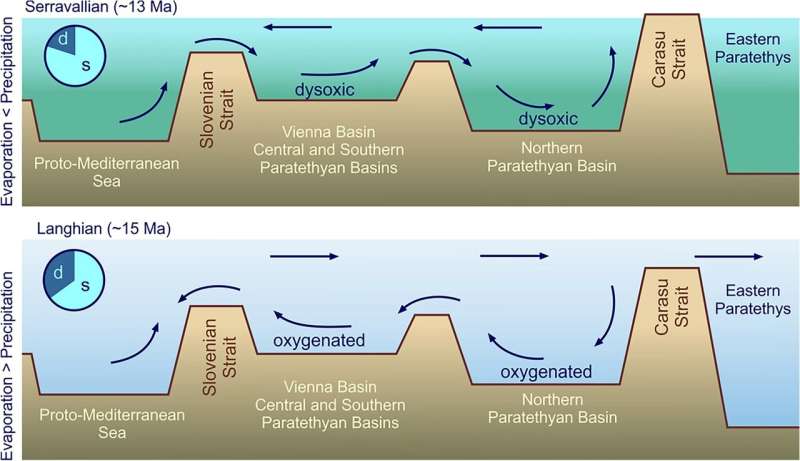This article has been reviewed according to Science X's editorial process and policies. Editors have highlighted the following attributes while ensuring the content's credibility:
fact-checked
peer-reviewed publication
proofread
Museum collections indicate Central Europe was a global biodiversity hotspot 15 million years ago

The collections of natural history museums are unique archives of evolution. They allow us to look far into the geological past. Shells of marine snails are particularly common fossils and are well suited to reconstructing climate history and former marine distributions.
A working group led by Mathias Harzhauser (NHM Vienna) has focused on the marine gastropods of the so-called Paratethys Sea, which covered large parts of Central and South-Eastern Europe between 35 and 11 million years ago. The paleontologists have now traced the history of this sea using more than 800 species of fossil marine snails from about 100 sites and have discovered an unexpected diversity.
The research is published in the journal Scientific Reports.
The combination of several factors was responsible for an unusually strong increase in biodiversity. As recently as 18 million years ago, a deep, west-east orientated sea stretched from Switzerland as far as Russia. The diversity of marine life was comparable to that of today's Mediterranean Sea.
About 16 million years ago, the landscape changed dramatically. The Alps were raised by the drifting of the African plate and the sea of the Alpine foreland dried up. Now the Carpathians began to rise out of the sea as an island arc. Numerous small islands formed within this arc.
By 15 million years ago, Central and Eastern Europe had finally transformed into a subtropical archipelago about 1,000 kilometers wide, remotely reminiscent of today's Caribbean. This highly structured marine landscape favored biodiversity. In addition, the Miocene climatic optimum reached its peak at this time.
Due to global warming, the European reef belt extended northwards and now reached as far as Eisenstadt. With the reefs also came many specialized species that lived as parasites on and in the corals. The coral reefs provided many ecological niches and acted as a booster of diversity.

Tectonics and global climate opened up a unique window of opportunity for booming biodiversity. "At that time, the Paratethys, a marginal sea of Eurasia in the Earth's history, was more than twice as rich in species as today's Mediterranean, and even harbored more species than today's Red Sea.
"Today, this Miocene biodiversity hotspot is only surpassed by the tropical diversity around the Philippines," says study leader Prof. Dr. Harzhauser, Director of the Geological-Paleontological Department of the NHM Vienna.
Using hundreds of sites, the paleontologists were also able to search for geographical patterns within the vanished sea. This revealed that the center of the biodiversity hotspot was in what is now Romania. Numerous new species emerged here.
However, the data also documents the end of the high altitude flight. Mighty ice sheets began to build up in the Antarctic 13.8 million years ago. With global cooling, the reefs of Central Europe also disappeared. The collapse of the ecosystems led to the extinction of two thirds of the species.
As a lot of water was now trapped in the ice, the sea level dropped by 50 meters worldwide. Former shallows now fragmented the sea and the faunas lost their connections.
"Locally restricted species now developed in the isolated ocean basins, which in turn were the starting point for smaller diversity hotspots. But the boom phase was over," says Dr. Thomas A. Neubauer from the Bavarian State Collection of Paleontology and Geology in Munich, who was responsible for the statistical analyses as co-author of the study.
When the sea was separated from the oceans by mountain building 12.7 million years ago, the subtropical diversity disappeared for good.
The analysis was made possible by the processing of thousands of finds in the collection of the Natural History Museum Vienna, which have been successively revised by the working group over more than two decades and published in more than 20 monographs. It was this enormously time-consuming work that provided the database for the analyses that have now been published in Scientific Reports.
More information: Mathias Harzhauser et al, The Central Paratethys Sea—rise and demise of a Miocene European marine biodiversity hotspot, Scientific Reports (2024). DOI: 10.1038/s41598-024-67370-6
Journal information: Scientific Reports
Provided by Naturhistorisches Museum Wien





















